Featured in The Fabricator magazine: Thermal spray and weld overlay applications are poised for growth

Most metals can be melted and “atomized” by liquid (normally water) or gas to form metal powders. Atomization is the most common method for producing metal and pre-alloyed powders, or powders consisting of two or more elements alloyed in the powder manufacturing process. Powder materials include iron and steel, stainless and nickel, tool steel, aluminum and copper, and their many alloys. Iron and steel account for 80 percent by weight of all metal powders produced annually.
Atomization accounts for nearly 70 percent by weight of all metal powders produced in North America. It is the main process for powder production because of its high production rates and economies of scale. Atomization also is the only way to produce pre-alloyed powders.
Producing metal powders involves melting raw materials in a crucible (induction melting furnace or electric arc being most common) and then pouring liquid metal into a vessel through one or several orifices. When the melt stream enters the vessel, the liquid metal is atomized by either water or gas, forming a spray of solid-state particles that can be irregular, pear, or spherical in shape.
Atomizers are sized by the melt capacity of the furnace, which may range from production batches of 250 kilograms to 100 tons. Powder production generally is optimized for its intended particle size distribution. Particle sizes range from submicron to 600 microns, depending on the finished product specification. After the powders are processed, they are classified, inspected, packaged, and delivered.



